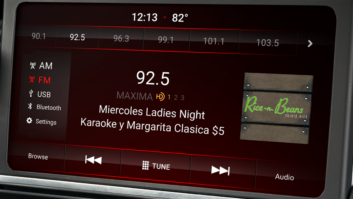It does not take much for me to overthink even the simplest matters.
I take trivia contests way too seriously. I believe beeswax is the best stuff around when it comes to polishing and waxing bees. I ponder the significance of the sugar cube and wonder why the Domino Sugar people don’t come out with sugar dodecahedrons “for a truly different cup of coffee.”
And heaven help us if a station puts me in charge of a simple promotion like a T-shirt giveaway at the mall. Within a half-hour, I’ll have been on the phone to arrange for a marching band and an Air Force flyover.
So it should not have come as any surprise that the latest innovations in computer technology had set me off on yet another obsessive-compulsive quest for the ultimate answer.
I am talking about hard drives.
Mine’s bigger
I enjoy reading what the futurists have to say about what’s-next for computers.
Back when I was tooling around with my Pentium 233 and heard about the 2 GHz barrier coming down within a few years, I started drooling. Now the stakes are around 3.0 GHz and getting higher, and I am up to my ankles in drool.
Recently, while checking out computer factoids on the Ziff-Davis Net (news.zdnet.co.uk), I was surprised to read about magnetic experiments now being explored by two professors at the State University of New York at Buffalo. Their efforts could, within seven years, lead to a 1 PB disk drive. So you know, a PB is a Petabyte, which is the same as 1 million GB.
Let’s let that one sink in and simmer for a few moments … 1 million bytes, times 1 billion. Right now, the most typical drive we would find on our own machines is about 40 to 60 GB, and the concept of a mere terabyte or two on the audio server is almost beyond comprehension for some.
So we are only seven years away from potentially having a Petabyte mounted on a single drive. Just what does that mean in terms of capacity and what on earth are we going to do with it all?
My math is a bit rusty these days, and actual drive capacities are hardly ever fully realized anyway – put a new 120 GB drive in your PC and watch it report about 111 GB back to you. But let us have a little fun with these numbers.
Out comes the calculator
It never really works this way in real life, but typically, a single minute of uncompressed CD-quality digital audio occupies about 10.6 MB, depending on whom you talk to. Simplified a little, that means about 56.4 seconds of audio fits into a nice round 10 MB.
Dropping in a zero the way our second-grade math teacher showed us how, it is seen that 100 MB will just about hold 564 seconds, or around 9 minutes 24 seconds. Bump it up to 1 GB (1,000 MB) and we are good to go for right around 94 minutes of CD-quality audio.
Let’s cut to the coda, as musicians say. Take that 1 GB of drive capacity and multiply it by 1 million to represent a Petabyte. You may have to go into your kitchen drawer and pull out an unused mantissa or two, but give the math a fair shot.
On paper only, that 1 Petabyte drive appears to be good for 94,000,000 minutes. Boil it down and see how this drive is theoretically large enough for 178 years of CD-quality audio!
Wait, we’re not done. Let’s add a little gentle data compression to our music to (snicker) conserve drive space. Maybe some MS-ADPCM or MPEG; either way, let’s make it a simple 4:1 compression. Yon hard drive is now up to well over seven centuries of music capacity.
The two most blatantly ridiculous aspects I find of all this: First, it is likely the drive will only carry a three-year warranty; and second, defragging said disk drive is a task likely to be completed by your descendants.
So that means …
This is why sick minds are never given powerful toys.
Once I had these numbers in hand, it set my mind to wand’rin’ and pond’rin’ how these developments can only come to radio’s rescue.
First, as the only limitation to this drive is what I now call the “178-Year Rule,” popular songs no longer need to adhere to any formula regarding time.
At one time, popular songs were only about 2-1/2 minutes in length, determined early on by how much music would literally “fit” on the surface of a 78-rpm record before hitting the lockgroove at the end.
Over the years, plenty of songs bent the rule before it finally broke. The singles “Hey Jude,” “Like a Rolling Stone” and “American Pie” all come to mind. Move into 33 rpm-Land and the trailblazers include “Time Has Come Today,” “Stairway to Heaven,” “In-a-Gadda-Da-Vida” and dozens of others.
Now, with a 1 Petabyte drive, the time limitation no longer applies. New songs can be as long as one wishes them to be.
We can finally go back and write additional verses to the 1:50 Box Tops’ hit “The Letter.” A Beach Boys tune truly can last “all summer long.” A song such as “Stairway to Heaven” would suddenly be too short to be a good bathroom tune.
Don McLean will be able to get back in his Chevy and revisit that levee when it’s wet. Alternative bands that record five-minute songs in one key can actually explore what it’s like to change to a new key and keep playing.
My friends at XM Satellite Radio claim you can listen to the same station cross-country. Hell, under my plan, you can listen to the same song cross-country!
That Web experience
A drive that huge can also store some pretty detailed – though insignificant – minutiae regarding artists, sent downline to Webcast listeners. It is one thing to tell your listeners how many albums Sheryl Crow has released since her debut. It is quite another to tell them what the GPS coordinates are for that beauty mark on her face.
That sort of capacity means every station in your cluster can keep its music library on one drive. Given a very generous 2,000-song music library per station, with each song being an average five minutes, an eight-station metro combo would only eat up 80,000 minutes on that drive – a mere 55 days worth of music. This still leaves around seven generation’s worth of room for commercials.
Was it Robert Klein or Albert Brooks who, back in the ’70s, did the fake commercial, “Now you can own every song ever recorded?” The good news about this huge drive is you could conceivably have a radio station that is able to store and play every song ever recorded!
Using 8:1 MPEG compression, our 1 Petabyte drive can hold about 14 centuries’ worth of audio. A library can be stocked for an all-request radio station that truly is able to play anything at all.
Imagine a typical quarter-hour, segueing from “Racing With the Moon” by Vaughn Monroe to a 16th century lute etude, then a snappy round of 19th century railroad songs like “Gandy Dancer’s Ball” leading you into the Vaudeville era favorite, “Mr. Gallagher, Mr. Sheen,” topped off with a Green Day medley.
Okay, the drawbacks
Sure, it won’t all be peaches and cream when this drive comes out and some new station comes on the air with the “Hits of the 1600s, 1700s, 1800s, 1900s and Today.”
First, all-request shows would be a joke. That Garth Brooks song you just phoned in won’t be played until your second grandchild gets fitted for his first dentures. There wouldn’t be any “two-hour turnover,” so if you missed a song because you were in the shower, tough luck.
Don’t even get me started on “Best Of” weekends or “Class Reunion” shows: “Here’s one for the class of ’01 … 1801, that is!”
You will never find that one song that the intern misspelled as it was entered into the computer. And the file name/number of the song will be several hundred digits long. Good luck if your automation system still uses the old DOS 8.3 file-naming convention!
However, we should consider one last optimistic point about the coming of the 1 Petabyte disk drive when it gets here.
You won’t need those RAID units filling the racks back in the server room anymore. Just locate the drive in the cafeteria and run an 80-pin ribbon cable down the hall to it. With every bit of station audio archived to a single component, a 1 Petabyte drive running 24/7 would also get hot enough to function as the burger grill in the employee lunchroom.
Al can be reached at alanpeterson@earthlink.net and has two words for anyone wishing to verify his math: “Geek Check!”







